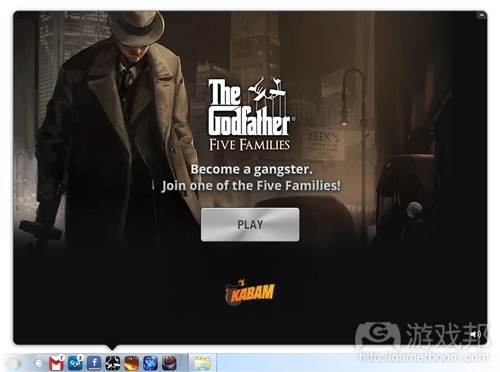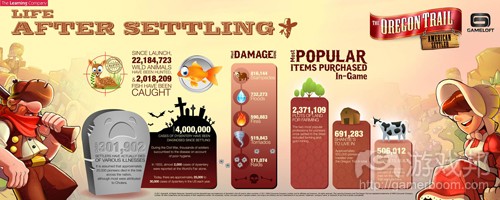每日观察:关注Mochi对Flash游戏开发者调查报告(12.21)
1)硬核社交游戏开发商Kabam最近通过SweetLabs旗下的Pokki平台,首次将其在线游戏推向桌面应用程序领域,支持玩家在无需打开网页浏览器的情况下,体验《Dragons of Atlantis》、《Edgeworld》、《Thirst of Night》以及《The Godfather: Five Families》等游戏,但仍需联网方可参与多人同步模式的游戏。
Pokki平台发布于今年6月,可将在线网页、应用和游戏包装为桌面应用程序。
2)NPD Group最近报告显示,美国游戏玩家上一季度在非传统零售游戏(游戏邦注:包括二手、出租、订阅、数字下载、社交及手机等类型的游戏)中投入16.4亿美元。
用户在零售渠道的新款游戏中投入13亿美元,加上游戏硬件及配件,用户总计向电子游戏行业投入42亿美元,同比2010年第三季度下降11%。
3)《Buzz!》开发商Relentless Software最近成立专注于开发社交及休闲游戏的数字业务部门,并聘请前EA成员James Wright任该部门执行制作人。
该公司之前已开发iOS游戏《Quiz Climber》、《蓝蛤蟆谋杀档案:谜语镇奇案》(在PS 3和Windows PC平台销量超过25万份)等数字产品。
4)拉美社交游戏公司Vostu最近在旗下在《MiniFazenda》和《MegaCity》这两款游戏(同时在Facebook、Orkut平台运营)中引进了广播服务,原因是Vostu团队发现原先在游戏中植入聊天和信息交流功能很占用屏幕面积,而音频渠道的作用却并未被多数游戏所发掘,他们从社交游戏的背景音乐获得了启发,所以决定在游戏中植入连续播放内容和音乐的广播电台功能。
这些游戏中的广播电台每天会循环播放三个小时的定制内容,其中多数内容是巴西音乐的流行音乐,有20%-30%时间播放的是游戏资讯、技巧、花边新闻、奇闻轶事和游戏视听攻略等。这种视听攻略是游戏机制的扩展,屏幕会显示玩家相关游戏任务的一半指导内容,并由电台DJ透露另一部分的内容。
约25%参与这项功能测试的玩家完成了视听任务,95%的测试玩家表示这种内置广播功能强化了游戏体验;游戏原先添加新功能时只能吸引一小部分新用户,但有35%玩家刚开始玩游戏就会收听广播内容,更重要的是,收听广播的玩家在游戏中的投入时间比一般用户多30%。
该公司表示《MegaCity》和《MiniFazenda》在Orkut的人气比在Facebook多10倍,但未并透露这两者在Orokut的具体用户数据。据AppData数据显示,《MegaCity》在Facebook的MAU为94万,《MiniFazenda》则是30万。据Vostu所称,公司游戏共有1800万至2000万左右的MAU,目前在Orkut、Facebook、MSN、Google+及其自主平台有4600万注册用户。
5)据games.com报道,尽管Blue Fang Games推出的社交游戏《The Oregon Trail》惨淡经营并面临关闭项目的绝境,但Gameloft推出的同一题材iPhone和iPad游戏却运营良好。
从The Learning Company和Gameloft两家公司最近发布的信息图表可以看出,该系列手机游戏自2008年发布以来下载量已超过300万次,游戏中已售出240万件虚拟商品,其中最受欢迎的是关于农耕和挖矿的道具。
6)据Mochi Media最近针对1000名Flash游戏开发者的调查报告显示,超过60%的受访者称其Flash游戏在2011年的流量及营收均比2010年显著增长(游戏邦注:其受访者是1075名Flash游戏开发者,该调查由Mochi Media、Adobe和FlashGameLicense.com共同执行),原因是游戏采用了更优化的盈利模式,以及开发者对Flash游戏开发的了解更上了一个台阶。
80%的Flash游戏开发者现居于美国之外的其他地区,美国、英国和加拿大Flash游戏开发者在两年前占比56%,但今年的这一比例仅剩37%。
俄罗斯Flash游戏开发者占比6%,印度、意大利、乌克兰和巴西分别占比3%。
Adobe已经中止Flash技术对手机网页浏览器的支持,但有许多开发者以原生应用的形式,将自己的Flash游戏移植到手机平台。
62%的开发者通过销售应用实现游戏收益,38%通过广告创收,11%采用微交易模式。
约60%开发者表示,自己将网页在线游戏作为开发手机游戏前测试市场反应的手段,有72%受访者将Android作为首选的手机开发平台,其次是占比67%的iOS平台。
多数没有全职工作的Flash开发者是学生群体,其中有80%受访者打算将开发游戏作为全职工作。
(本文为游戏邦/gamerboom.com编译,拒绝任何不保留版权的转载,如需转载请联系:游戏邦)
1)Kabam’s Social Games Come To Desktops Through Pokki
by Eric Caoili
Newsbrief: Kabam has made several of its core-targeted social gamesavailable as desktop applications for the first time, using SweetLabs’ Pokki platform to convert the online titles into PC apps.
Users can now access traditionally Facebook/Google+ games like Kabam’s Dragons of Atlantis, Edgeworld, Thirst of Night, and The Godfather: Five Families without needing to open a web browser, though an online connection will still be required to play the multiplayer, synchronous strategy games.
Launched in June, the Pokki platform is built to package online sites, applications, and games as desktop programs. This Kabam announcement marks one of SweetLabs’ first partnerships with a game developer.
To entice more developers to bring their games to Pokki, SweetLabs launched a $50,000 contest to reward studios that release games built with HTML5, CSS3, and Javascript on its platform. (source:gamasutra)
2)U.S. Gamers Spent More Outside Of Stores Last Quarter
by Frank Cifaldi
Video game consumers spent most of their money on games outside of traditional retail stores last quarter, a new report has revealed.
According to The NPD Group, a total of $1.64 billion dollars was spent on video game software outside of traditional, new packaged goods. This incorporates used games, rentals, subscriptions, digital downloads, social network games, downloadable add-ons, and mobile games.
By comparison, $1.3 billion was spent in retail channels on new video games. Counting hardware and accessories, total video game industry spend was $4.2 billion dollars. That figure represents an 11 percent decline over Q3 2010, according to the group, due mostly to the rough year physical game sales have seen in 2011.
The full report, “U.S. Games Market Dynamics,” is available through The NPD Group. (source:gamasutra)
3)Buzz! Creator Relentless Opens Digital Casual Division
by Mike Rose
Buzz! developer Relentless Software has launched a new digital division within the company, that will focus on developing social and casual games.
The company has already produced a number of digital titles in the past, including Quiz Climber for iOS, and Blue Toad Murder Files: The Mysteries of Little Riddle, the latter of which has sold over quarter of a million copies on PlayStation 3 and Windows PC.
In a statement today, Relentless executive director Andrew Eades said, “The digital division in Relentless has been established as a separate division that reports to me as CEO.”
“We’re serious about social and mobile games and that’s why we have taken the logical step to separate these activities from the console business.”
He also revealed that the company has hired former EA staffer James Wright as the division’s executive producer. “The formalisation of the Digital Division is a valuable starting point to take over from Relentless’ self-publishing strategy,” said Wright.
This move is just one part of Relentless’ push in the casual gaming space. Earlier this year, the company began making games for PlayJam’s interactive casual TV gaming network.
It later revealed that it is porting popular casual game Slingo, originally developed by Slingo, Inc, which has been downloaded over 3 billion times to date, to the TV network. (source:gamasutra)
4)Vostu is Betting In-Game Radio Service for Social Games Will Be A Chart Topper
Kathleen De Vere
Latin American social gaming company Vostu is taking to the airwaves with new in-game radio stations for its two most popular social games, MiniFazenda and MegaCity. The service — the first of its kind in social games — is now available for players on Facebook and Orkut.
The in-game radio is the result of four months of rapid development, testing, licensing, and a highly successful beta period Vostu Co-Founder and Chief Scientist Mario Schlosser tells us. The idea was born after the Vostu team started to realize how much of a premium on-screen real estate was at.
“The way social games work and how they become a good business is not by having one breakout hit, but by understanding how to make users move between your games to keep churn on your userbase low,” explains Schlosser. “[We were implementing] chat and messaging between games and we suddenly realized that anything we jam into these games takes away from the real estate on the screen. But one channel that’s totally underexploited is the audio channel. All social games seem to have this ridiculously cheesy elevator ‘muzak’ running in the background, so we thought, why don’t we do something with that channel?”
Audio-visual content had already proven to be a big hit with MegaCity players after a spring campaign with with Brazilian singer/actress Ivete Sangalo, so the plan quickly came together to create an in-game radio station with continuous content and music.
The in-game stations are updated with three new hours of custom content every day that plays on a loop, meaning the overwhelming majority of players will be able to tune in and hear something new every day. While most of the in-game radio content is Brazilian country and pop music, 20% to 30% of the airtime is devoted to in game statistics, tips, trivia, anecdotes, and the most popular feature so far, audio-visual quests.
The quests are an extension of a fairly standard social game mechanic; instead of being given explicit instructions on what to do and how to do it, players in MegaCity and MiniFazenda will now encounter quests that will require players to tune in, with half the instructions being seen on screen and the other half only revealed by the DJ.
About 25% of users in the beta test completed an audio-visual quest, but according to Schlosser the new content quickly began to take on a life of its own. “You had to be a specially selected test user to see the radio when you were playing the game,” he says. “But even though only a small number of users could learn about the audio-visual quests, all of their friends also participated in them and got the rewards — the people who had access to the radio went out and told their friends about the quests.”
According to Vostu, 95% of players in the beta test reported that the in-game radio made playing the game better. While new features added to social games typically start off with a trickle of new users, 35% of players started listening to the in-game radio right away — a high number according to Schlosser. Even more importantly, players who listened to the in-game radio played for 30 percent longer on average.
“The biggest goal we have for the radio is increasing engagement,” says Schlosser. “One of the most sticky things we generally see in the games is the login behavior people have. You’re not building your day around the games, you’re building the gameplay around your day, so you have people that play at 8 o’clock in the morning before they go to work and 8 o’clock at night when they come back from work. People have these patterns and they stick to them, so increasing session times is tremendously hard. This was an incredibly powerful thing when we realized it made people stick around longer in the game. We realized we had to get it out as soon as we could.”
Vostu already has plans to incorporate it into both of the new social games it has slated for release in the first quarter of 2012, rolling it out after the games have launched in order not to overwhelm players with new features. That said, in-game radio won’t be coming to GolMania, or Vostu’s upcoming female-focused casual-social game though, as players don’t tend to play those kinds of games for long enough at a time to make a service like in-game radio worthwhile according to Schlosser.
While the company didn’t reveal exactly how many users MegaCity and MiniFazenda have on Orkut, the developer did tell us the game are about 10 times as popular Orkut as they are on Facebook. According to AppData, MegaCity currently has 940,000 MAU and MiniFazenda 300,000 MAU on Facebook. Schlosser reveals that, overall, Vostu has between 18 to 20 million MAU. It currently enjoys 46 million registered users on Orkut, Facebook, MSN, Google+ and its own proprietary platform.(source:insidesocialgames)
5)One Oregon Trail withers away while another flourishes [Infographic]
by Joe Osborne
You could say that in one parallel universe, The Oregon Trail is a flourishing path to the West. In the other, unfortunately, it’s about to be ripped from existence, nothing but a memory. That is, if you’re trying to keep canon. As Blue Fang Games’s social take on the classic educational PC game is about to shut down, Gameloft’s mobile approach seems to be doing just fine.
Gameloft’s The Oregon Trail series on iPhone and iPad seems to be doing so well in fact, that The Learning Company and the French mobile game developer have released an infographic touting its many milestones. Since Gameloft released its first entry into the series in 2008 and just recently its sequel, American Settler, The Oregon Trail has been downloaded over 3 million times collectively.
Such numbers have led to 22,184,723 wild animals hunted since launch, with 2,018,209 fish caught. On a rather gross note, over 4 million cases have been diagnosed in the games since launch. The biggest threat to caravans crossing the nation has been stampedes with 816,144 incidents, followed by 732,273 floods, 590,883 fires and more. The most popular item purchased in Gameloft’s The Oregon Trail games is none other than the farming plot–go figure. Nearly 2.4 million of the things have been purchased in-game.
Click the image above to make it larger.
Of course, these numbers dwarf the significant numbers of hardships on the real Oregon Trail . What’s even more interesting is how these numbers belittle The Oregon Trail on Facebook, which The Learning Company will shutter come Jan. 6. That’s especially considering how similar American Settler and the social game look. At least folks can get their fix of digital dysentery somewhere.(source:games)
6)Flash games are still generating strong traffic and revenue growth for developers
Dean Takahashi
The Flash game market is thriving. Developers have sprouted up around the world. They’re creating mobile games based on their Flash web games, and they are making more money and getting stronger traffic, according to a survey of more than 1,000 Flash game developers by Mochi Media.
More than 60 percent of Flash game developers saw an increase in traffic and revenue in 2011 compared to 2010. The growth has been enabled by improved monetization and a better understanding of the best practices for Flash games and development platforms.
The 2011 Flash Games Market Survey says that 80 percent of Flash game developers reside outside the U.S. now. Developers in the U.S., Great Britain and Canada accounted for about 56 percent of all Flash developers two years ago but only make up 37 percent of respondents this year.
Russia accounts for 6 percent, India 3 percent, Italy 3 percent, Ukraine 3 percent, and Brazil 3 percent.
And while Adobe has discontinued the development of a mobile version of Flash to run on mobile phone web browsers, developers are still adapting their Flash games so that they run on mobile devices via native apps.
About 62 percent of developers use app sales to monetize their games. About 38 percent use ads, and 11 percent use micro-transactions. That latter figure is growing but it is still an unusual way to make money from games, said Colin Cupp, product marketing manager at Mochi, in an interview.
“Flash is becoming more mature with more ways to monetize games,” he said.
About 60 percent of Flash developers say they make an online web game first to gauge market response before developing for mobile platforms. Android was the top target for mobile development, at 72 percent, followed by Apple’s iOS, at 67 percent.
Cupp said that developers are interested in Flash games with 3D graphics using new technologies. Most of the Flash developers who don’t work on it full time are students, and about 80 percent of them want to make games on a full-time basis.
The survey of 1,075 developers and publishers was conducted by Mochi Media, Adobe and FlashGameLicense.com.
Mochi Media will sponsor a Flash Gaming Summit 2012 in San Francisco in March 4. Early bird passes are on sale until Dec. 31.
Mochi Media offers an ad network, analytics, and monetization tools for Flash games with more than 150 million monthly active users, 55,000 games and 60,000 publishers. Mochi is based in San Francisco and is owned by Shanda Games in China.(source:venturebeat)











































 闽公网安备35020302001549号
闽公网安备35020302001549号